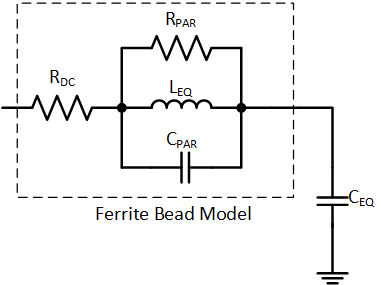SLOA339 July 2024 TAS2764 , TAS2764 , TAS2780 , TAS2780 , TAS2781 , TAS2781
1.3 Ferrite Bead Filters
Ferrite beads are relatively low cost and non-linear EMI filters. The impedance of the ferrite bead changes significantly with the current through the ferrite bead, which makes this component non-linear. The ferrite bead can be modeled as a resistor parallel with an inductor, which damps the resonance and reduces extremely high current.
 Figure 1-1 Ferrite Bead Equivalent
Model
Figure 1-1 Ferrite Bead Equivalent
ModelThe inductor in the filter can be realized using a ferrite bead, which is a lot more cost optimum compared to a regular inductor, but comes with non-linearities. Using the cost-optimum ferrite beads degrades the THD performance of the audio after the filter, affecting the audio performance of the end system. Such concerns force the customers to go back to an inductor-based filter, or use a more expensive ferrite bead which doesn’t degrade the THD performance, increasing the cost of the end system. Another concern with using a filter at output of class-D amplifier is that the filter degrades the frequency response of the output depending upon the cut-off frequency selected for the filter. This too affects the audio performance across frequencies.
Table 1-1 compares cost of different inductors and ferrite beads. TI’s Post filter feedback configuration allows usage of MPZ1608S221A and 2506036017Y2 kind of ferrite beads which is significantly lower cost design, without the performance degradation associated with these components.
| Part Number | Type | 9k unit price | Performance |
|---|---|---|---|
| MAKK2016TR24M | Inductor | 3.1c | High |
| NFZ2MSM181SN10L | Ferrite bead | 11.1c | High |
| MPZ1608S221A | Ferrite bead | 2.1c | Low |
| 2506036017Y2 | Ferrite bead | 1.9c | Low |